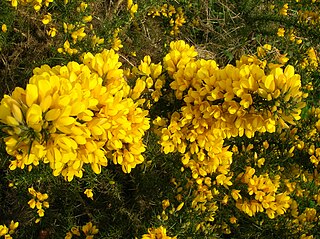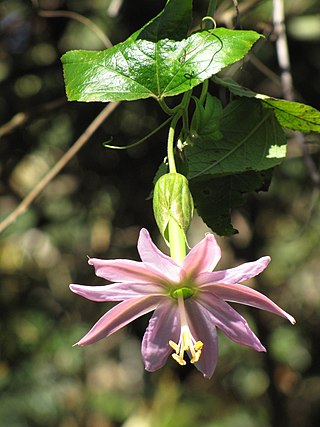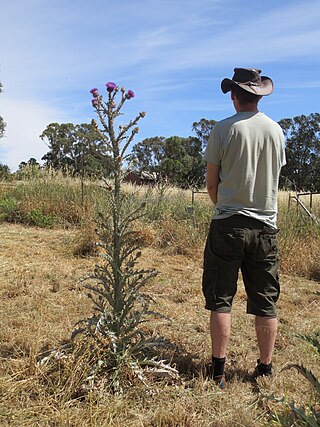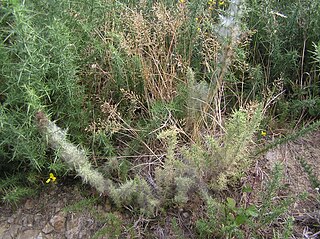
Gorse ( Ulex europaeus ) was introduced to New Zealand in the early stages of European settlement. It is now a major invasive plant species with millions of dollars spent on its control.

Gorse ( Ulex europaeus ) was introduced to New Zealand in the early stages of European settlement. It is now a major invasive plant species with millions of dollars spent on its control.
Introduced from Western Europe in the very early stages of European settlement, it was recorded by Charles Darwin during his voyage through New Zealand waters in 1835 as growing in hedges in the Bay of Islands. [1] Its spread and development as a weed in New Zealand's temperate climate was rapid, but settlers failed to recognise the threat; gorse seed continued to be imported and plantings deliberately established into the 1900s.
Gorse has been used for hedges and windbreaks on the Canterbury Plains since the 1850s. These windbreaks have a combined length of 300,000 kilometres. [2]

Gorse has been found to form a useful nursery for many species for native bush regeneration. When young, gorse bushes are very dense. As they grow older, they become 'leggy', and provide the ideal conditions for native seeds to germinate and grow. The native seedlings grow up through the gorse, cutting out its light and eventually replacing it. This technique is working successfully and within a short time frame at Hinewai Reserve on Banks Peninsula.

The introduction resulted in large spreading infestations over hundreds of hectares, peaking in the late 1940s. It was recognised as a threat as early as 1861 with the Provincial Council in Nelson passing an act to prevent the planting of gorse hedges. [3] The seed can lie dormant on the ground for up to 50 years, germinating quickly after the adults have been removed. Unfortunately, most methods of removing adult gorse plants, such as burning or bulldozing them, create the ideal conditions for the gorse seeds to germinate and total eradication with current technology seems impossible. Gorse is now one of the most widely recognised agricultural weeds in New Zealand. It covers 700,000 hectares (1,700,000 acres) at varying densities — a total of 5% of the land area of New Zealand when excluding existing indigenous forest, vegetated sub-alpine and alpine areas. [4] Gorse became New Zealand's most costly weed to control, an estimated $22 million per annum by the early 1980s. [5]
Current research areas are active management of control agents, development of a bioherbicide, and the use of modelling. [6]
Biological pest control of gorse has been investigated since the 1920s. [7] Seven different agents have been released in New Zealand. Results have been mixed, but in general neither the seed-feeding nor foliage-feeding insects are doing enough damage to be viable as a stand-alone control agent. [8]

Weed control is a type of pest control, which attempts to stop or reduce growth of weeds, especially noxious weeds, with the aim of reducing their competition with desired flora and fauna including domesticated plants and livestock, and in natural settings preventing non native species competing with native species.

Ulex is a genus of flowering plants in the family Fabaceae. The genus comprises about 20 species of thorny evergreen shrubs in the subfamily Faboideae of the pea family Fabaceae. The species are native to parts of western Europe and northwest Africa, with the majority of species in Iberia.

Onopordum acanthium is a flowering plant in the family Asteraceae. It is native to Europe and Western Asia from the Iberian Peninsula east to Kazakhstan, and north to central Scandinavia, and widely naturalised elsewhere, with especially large populations present in the United States and Australia. It is a vigorous biennial plant with coarse, spiny leaves and conspicuous spiny-winged stems.

A number of introduced species, some of which have become invasive species, have been added to New Zealand's native flora and fauna. Both deliberate and accidental introductions have been made from the time of the first human settlement, with several waves of Polynesian people at some time before the year 1300, followed by Europeans after 1769.

Cirsium arvense is a perennial species of flowering plant in the family Asteraceae, native throughout Europe and western Asia, northern Africa and widely introduced elsewhere. The standard English name in its native area is creeping thistle. It is also commonly known as Canada thistle and field thistle.

Ulex europaeus, the gorse, common gorse, furze or whin, is a species of flowering plant in the family Fabaceae, native to Western Europe.

Passiflora tarminiana is a species of passionfruit. The yellow fruits are edible and their resemblance to small, straight bananas has given it the name banana passionfruit in some countries. It is native to the uplands of tropical South America and is now cultivated in many countries. In Hawaii and New Zealand it is now considered an invasive species. It was given the name banana passionfruit in New Zealand, where passionfruit are also prevalent. In Hawaii, it is called banana poka. In its Latin American homeland, it is known as curuba, curuba de Castilla, or curuba sabanera blanca (Colombia); taxo, tacso, tagso, tauso (Ecuador); parcha, taxo (Venezuela), tumbo or curuba (Bolivia); tacso, tumbo, tumbo del norte, trompos, tintin, porocsho or purpur (Peru).

Osteospermum moniliferum is an evergreen flowering shrub or small tree in the daisy family, Asteraceae. It is native to southern Africa, ranging through South Africa and Lesotho to Mozambique and Zimbabwe.
This is an alphabetical index of articles related to gardening.

A noxious weed, harmful weed or injurious weed is a weed that has been designated by an agricultural or other governing authority as a plant that is injurious to agricultural or horticultural crops, natural habitats or ecosystems, or humans or livestock. Most noxious weeds have been introduced into an ecosystem by ignorance, mismanagement, or accident. Some noxious weeds are native. Typically they are plants that grow aggressively, multiply quickly without natural controls, and display adverse effects through contact or ingestion. Noxious weeds are a large problem in many parts of the world, greatly affecting areas of agriculture, forest management, nature reserves, parks and other open space.

Lachenalia reflexa is species of the genus Lachenalia endemic to lowland areas near Cape Town, South Africa.

Carthamus lanatus is a species of thistle known as woolly distaff thistle, downy safflower or saffron thistle. It is closely related to safflower. This annual plant is a native of the Mediterranean Basin, but it is familiar in other places where it was introduced and has become a noxious weed, such as in parts of North America and southern Australia with similar climates.

Exapion ulicis is a species of straight-snouted weevil known by the general common name Gorse Seed Weevil. It is used as an agent of biological pest control against Common Gorse, which is classified as a noxious weed in some countries.

Cydia succedana, or Gorse Pod Moth is a species of moth of the family Tortricidae. It is found in Europe and has been introduced to New Zealand.

Old man's beard is an invasive plant in New Zealand that affects indigenous biodiversity. It is declared an unwanted organism under the Biosecurity Act 1993 which means it cannot be sold, distributed or propagated.

Biological control programs for gorse in New Zealand have existed since the introduction of the gorse seed weevil in 1928. Biological pest control is the use of natural mechanisms such as predation to limit the growth and prevalence of a pest. The early research into the biological control of common gorse in New Zealand was among the first of such programs worldwide.

Entyloma ageratinae, commonly known as the mist flower smut, is a leaf smut fungus and plant pathogen widely employed as a biological herbicide in the control of the invasive plant Ageratina riparia. The pathogen was first identified in Jamaica in 1974 and was isolated as a distinct species in 1988.

In Australia, Mimosa pigra has been declared a noxious weed or given similar status under various weed or quarantine Acts. It has been ranked as the tenth most problematic weed and is listed on the Weeds of National Significance. It is currently restricted to the Northern Territory where it infests approximately 80,000 hectares of coastal floodplain.

Senecio hispidulus, the hill fireweed or rough groundsel, is a species of flowering plant in the daisy family. It is found in many parts of Australia.

Ozothamnus leptophyllus, commonly known as tauhinu or cottonwood, is an endemic shrub of New Zealand. Tauhinu is fast-growing, reaching 2 metres in height and is a common plant of coastal farmland. This species is host to the larvae of the New Zealand endemic moth Homoeosoma anaspila.